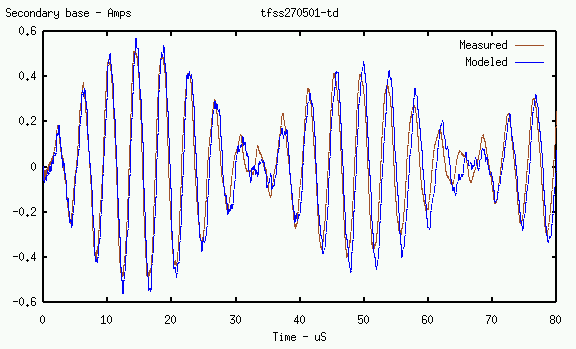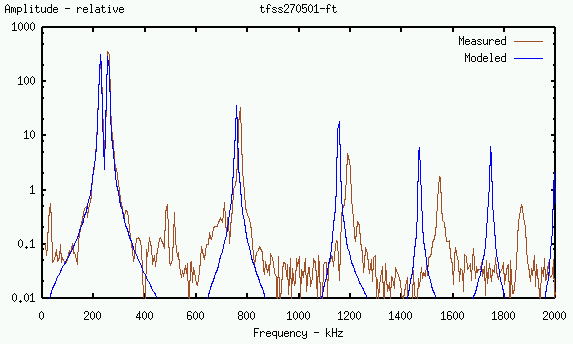Secondary base current was captured at a time resolution of 20nS, and modeled at the same time resolution.
Comparison of modeled and measured secondary base currents.
| Introduction |
The time domain modeling must determine what modes are available to the Tesla coil, their frequencies, Q factors and
current profiles. It must then determine what composition of mode amplitudes and phases are required to match the
starting conditions of the resonator. Finally, the predicted waveform and its Fourier spectrum can be generated.
As an end-to-end cross check on this whole process, a predicted secondary base current has been compared with
actual waveforms as measured by Terry Fritz. These tests were carried out at low voltage using a solid state
gap. This web page compares the results.
| Test Setup and Data |
![]() Test setup
Test setup
Secondary base current was captured at a time resolution of 20nS, and modeled at the same time resolution.
![]() Raw data CSV
10k records, 174k bytes.
Raw data CSV
10k records, 174k bytes.
| Results and Analysis |
The coil was modeled at a spatial resolution of 500 steps for Cext, 300x300 for Ms, 32x32 for Cint, 1x300 for Mp, and 250 for Ctor.

We see reasonable agreement with the overall beat envelope, which
indicates that the primary coupling is correctly determined. Slight error
(~0.5%) in the frequencies of the first two modes results in a gradually
increasing phase error across the trace. The primary loss resistance has
been adjusted to match the observed decay rate - 0.3 ohms was required.
A good match is achieved on the first cycle of the base current, which
is far from sinusoidal. The initial negative going transient, followed
by a recovering ramp upwards, in which the 3rd mode is prominent, are
reproduced in the model.
At the first base current notch, we again see a glimpse of mode 3
coming through, although by now the calculated phase is beginning
to deteriorate. By the second notch, the phase of the higher modes is
effectively random, and the amplitudes computed by the model are higher,
due to the model's tendency to over-predict the higher mode Q factors. In
the actual coil, these are decaying rather more rapidly.
The graph below shows a Fourier spectrum of the above waveforms.

The error in placement of the higher modes gradually increases with
frequency, due mainly to the limited spatial resolution (32x32) of the
internal capacitance determination. As a result, the model cannot be
expected to predict the precise phase of the higher modes, beyond the
first few cycles. Note the over-prediction of amplitudes for the 4th
and higher modes. These are decaying rather more rapidly in the real coil.
The measured spectrum is exhibiting some intermodulation on components
with less than 1% amplitude, as well as a clear second harmonic of the
main two modes, at around -50dB. We cannot determine without further
measurements whether these components arise from non-linearity in the
coil or the instruments. Some rectification is occuring, as evidenced
by the component appearing in the measured response down at the beat
envelope frequency.
The quality of the measured traces, in terms of their low noise and
freedom from interference, demonstrates the advantage of using a solid
state gap for this kind of experimental work.